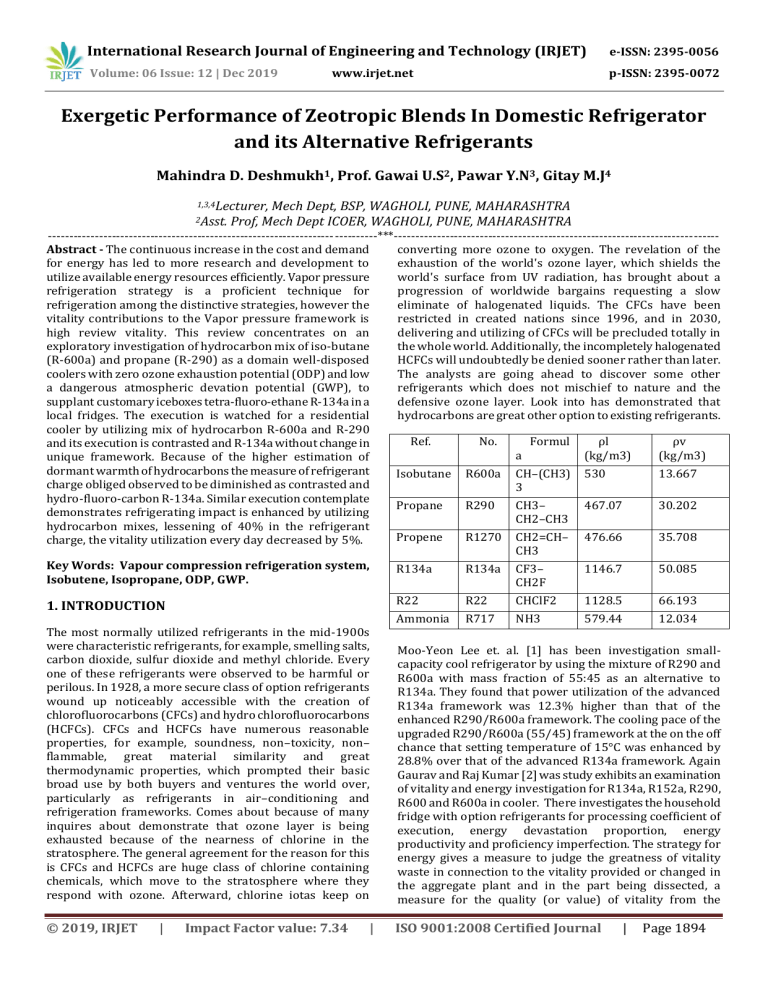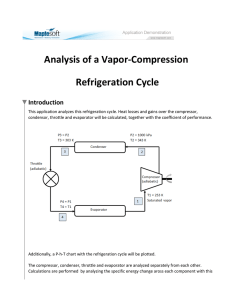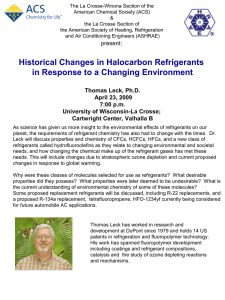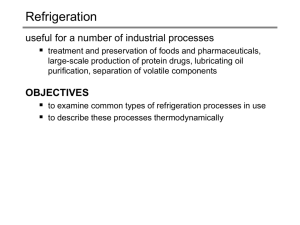IRJET-Exergetic Performance of Zeotropic Blends in Domestic Refrigerator and its Alternative Refrigerants
advertisement

International Research Journal of Engineering and Technology (IRJET) e-ISSN: 2395-0056 Volume: 06 Issue: 12 | Dec 2019 p-ISSN: 2395-0072 www.irjet.net Exergetic Performance of Zeotropic Blends In Domestic Refrigerator and its Alternative Refrigerants Mahindra D. Deshmukh1, Prof. Gawai U.S2, Pawar Y.N3, Gitay M.J4 1,3,4Lecturer, 2Asst. Mech Dept, BSP, WAGHOLI, PUNE, MAHARASHTRA Prof, Mech Dept ICOER, WAGHOLI, PUNE, MAHARASHTRA -----------------------------------------------------------------------------***---------------------------------------------------------------------------Abstract - The continuous increase in the cost and demand converting more ozone to oxygen. The revelation of the for energy has led to more research and development to exhaustion of the world's ozone layer, which shields the utilize available energy resources efficiently. Vapor pressure world's surface from UV radiation, has brought about a refrigeration strategy is a proficient technique for progression of worldwide bargains requesting a slow refrigeration among the distinctive strategies, however the eliminate of halogenated liquids. The CFCs have been vitality contributions to the Vapor pressure framework is restricted in created nations since 1996, and in 2030, high review vitality. This review concentrates on an delivering and utilizing of CFCs will be precluded totally in exploratory investigation of hydrocarbon mix of iso-butane the whole world. Additionally, the incompletely halogenated (R-600a) and propane (R-290) as a domain well-disposed HCFCs will undoubtedly be denied sooner rather than later. coolers with zero ozone exhaustion potential (ODP) and low The analysts are going ahead to discover some other a dangerous atmospheric devation potential (GWP), to refrigerants which does not mischief to nature and the supplant customary iceboxes tetra-fluoro-ethane R-134a in a defensive ozone layer. Look into has demonstrated that local fridges. The execution is watched for a residential hydrocarbons are great other option to existing refrigerants. cooler by utilizing mix of hydrocarbon R-600a and R-290 Ref. No. Formul ρl ρv and its execution is contrasted and R-134a without change in a (kg/m3) (kg/m3) unique framework. Because of the higher estimation of dormant warmth of hydrocarbons the measure of refrigerant Isobutane R600a CH–(CH3) 530 13.667 charge obliged observed to be diminished as contrasted and 3 hydro-fluoro-carbon R-134a. Similar execution contemplate Propane R290 CH3– 467.07 30.202 demonstrates refrigerating impact is enhanced by utilizing CH2–CH3 hydrocarbon mixes, lessening of 40% in the refrigerant Propene R1270 CH2=CH– 476.66 35.708 charge, the vitality utilization every day decreased by 5%. CH3 Key Words: Vapour compression refrigeration system, R134a R134a CF3– 1146.7 50.085 Isobutene, Isopropane, ODP, GWP. CH2F 1. INTRODUCTION R22 R22 CHClF2 1128.5 66.193 The most normally utilized refrigerants in the mid-1900s were characteristic refrigerants, for example, smelling salts, carbon dioxide, sulfur dioxide and methyl chloride. Every one of these refrigerants were observed to be harmful or perilous. In 1928, a more secure class of option refrigerants wound up noticeably accessible with the creation of chlorofluorocarbons (CFCs) and hydro chlorofluorocarbons (HCFCs). CFCs and HCFCs have numerous reasonable properties, for example, soundness, non–toxicity, non– flammable, great material similarity and great thermodynamic properties, which prompted their basic broad use by both buyers and ventures the world over, particularly as refrigerants in air–conditioning and refrigeration frameworks. Comes about because of many inquires about demonstrate that ozone layer is being exhausted because of the nearness of chlorine in the stratosphere. The general agreement for the reason for this is CFCs and HCFCs are huge class of chlorine containing chemicals, which move to the stratosphere where they respond with ozone. Afterward, chlorine iotas keep on Ammonia R717 NH3 579.44 12.034 Moo-Yeon Lee et. al. [1] has been investigation smallcapacity cool refrigerator by using the mixture of R290 and R600a with mass fraction of 55:45 as an alternative to R134a. They found that power utilization of the advanced R134a framework was 12.3% higher than that of the enhanced R290/R600a framework. The cooling pace of the upgraded R290/R600a (55/45) framework at the on the off chance that setting temperature of 15°C was enhanced by 28.8% over that of the advanced R134a framework. Again Gaurav and Raj Kumar [2] was study exhibits an examination of vitality and energy investigation for R134a, R152a, R290, R600 and R600a in cooler. There investigates the household fridge with option refrigerants for processing coefficient of execution, energy devastation proportion, energy productivity and proficiency imperfection. The strategy for energy gives a measure to judge the greatness of vitality waste in connection to the vitality provided or changed in the aggregate plant and in the part being dissected, a measure for the quality (or value) of vitality from the © 2019, IRJET | Impact Factor value: 7.34 | ISO 9001:2008 Certified Journal | Page 1894 International Research Journal of Engineering and Technology (IRJET) e-ISSN: 2395-0056 Volume: 06 Issue: 12 | Dec 2019 p-ISSN: 2395-0072 www.irjet.net thermodynamic perspective and a variable to characterize objective efficiencies for vitality frameworks. It is built up that in the present work productivity imperfection is most extreme in condenser and least in evaporator. Examination of different properties for option refrigerants has been accomplished for a residential fridge. Mohd. Aasim Nazeer Ahmad Quraishi [3] was available on investigation of various natural benevolent refrigerants of either hydrocarbon or Hydro fluoro carbons (HFC) class. Hydrocarbons (HCs) have zero ODP and low GWP while HFCs have zero ODP yet a very higher GWP. Nearly in every one of the cases, when R-134a was supplanted with HCs the COP of the framework was made strides. Rajanikant Y. Mahajan [4] was completed on his test investigation of various condition benevolent refrigerants with zero ozone consumption potential (ODP) and immaterial an Earth-wide temperature boost potential (GWP), to supplant R134a in local cooler. Dr. A. G. Matani and Mukesh K. Agrawal [5] was study on substantial number of refrigerants, which are utilized to exchange warm from low temperature supply to high temperature repository by utilizing vapor pressure refrigeration framework. M. G. Almeida [6] et. al. has examine endeavors and improvement in the refrigeration and cooling division connected to the utilization of regular refrigeration liquids is not connected just with the need to protect nature alone, however has extraordinary significance as to the inactive requirement for vitality effective gear. P.Thangavel [7]et. al. has been examination on the execution of pressure cycle is evaluated hypothetically with various refrigerants. In pressure refrigeration framework, hydrocarbon refrigerants, for example, R290 and R600a are considered as a refrigerant by blending of these at various mass divisions around 20%+80%, 25%+75%, 50%+50% and 75%+25% separately. is finished with the assistance of nitrogen gas then clearing is completed with the assistance of vacuum pump and refrigerant is accused of the assistance of charging framework. The refrigerant accuse necessity of hydrocarbons is little because of their higher dormant warmth of vaporization. According to the cooler fabricates suggestion amount of charge necessity for HFC134a was 500 g. In the test, refrigerant charge is 10% higher because of the nearness of instruments and associating lines and so forth. To advance the zeotropic mix of R600a and R290 (50/50) refrigerant charge, the icebox is accused of 170g and the execution was examined. The test systems were rehashed and take the perusing for various blends from the different modes. Fig. 1: Experimental Set-up I. Design and Development of Experimental Set-up This segment gives a portrayal of the offices produced for leading test deal with a local cooler. The strategy of charging and clearing of the framework is additionally talked about here. The trial setup of the test unit and device is appeared in the Figure1. Distinctive exploratory and hypothetical correlation will performed to assess the execution of residential fridge by utilizing diverse refrigerants. In this exploratory investigation of zeotropic mix of R600a and R290 is contrasted and the R-134a in a household refrigeration framework. To play out the trial 40L icebox is chosen which was intended to work with R-134a. It is comprises of an evaporator, air cooled condenser, development gadget and responding compressor. The cooler was instrumented with two weight gages at channel and outlet of the compressor. The temperature at six unique focuses is taken by six temperature sensors are mounted to gauge the compressor delta temperature, compressor conveyance temperature, evaporator bay temperature, evaporator outlet temperature, the cooler temperature and bureau temperature. An ammeter is mounted at the delta of the compressor to quantify the power supply and voltmeter is additionally utilized for voltage of supply. Initially cleaning A. Specification for Experimental Set-up: © 2019, IRJET ISO 9001:2008 Certified Journal | Impact Factor value: 7.34 | Water cooler –CAJ34G (KCJ444HAG) Capacity (litres/hour): 40 Condenser size: 3/8’’ O.D. 10-12 FPI -11’’× 10’’× 3’’Row Condenser fan motor: 1/36 H.P. × 1350 RPM Condenser fan: 10’’ Diameter Evaporator tube: Size × Length 3/8’’ O.D.×50’’ Capillary: Bore × Length0.050’’ ×5’× 1 number HFC-134a commercial back pressure compressor Cooling capacity: 1720 Btu/hr 433 kcal/hr Rated Power and Current: 330 W and 2.34 A Displacement: 12.58 cc/rev | Page 1895 International Research Journal of Engineering and Technology (IRJET) e-ISSN: 2395-0056 Volume: 06 Issue: 12 | Dec 2019 p-ISSN: 2395-0072 www.irjet.net a degree of the imperativeness commitment to the weight strategy is traded to the refrigerant. Cooling type fan: 350 CFM Oil charge quantity: 890 cc 3 – 4: The high weight superheated gas goes from the compressor into the condenser. The basic bit of the cooling method (3 - 3a) desuper heats the gas before it is then changed at the end of the day into liquid (3a - 3b). The cooling for this method is for the most part finished by using air or water. A further decline in temperature happens in the pipe work and liquid recipient (3b - 4), so that the refrigerant liquid is sub-cooled as it enters the augmentation contraption. Temperature range:-50 to + 80 °C Humidity range for temp. Sensor :5% to 80% Accuracy: ± .1 °C Distinguish: 0. 1 °C Power: two button battery (LR44, 1.5v) B. Test Methodology: Heat Flow actually from a hot to a colder body. In refrigeration framework the inverse must happen i.e. warm spills out of an icy to a more blazing body. This is accomplished by utilizing a substance called a refrigerant, which retains warm and subsequently bubbles or dissipates at a low weight to shape a gas. This gas is then compacted to a higher weight, with the end goal that it exchanges the warmth it has picked up to surrounding air or water and turns back (consolidates) into a fluid. Along these lines warmth is consumed, or expelled, from a low temperature source and exchanged to a higher temperature sources. This is a premise of vapor pressure cycle. 4 – 1: The high-weight sub-cooled liquid experiences the improvement contraption, which both abatements its weight and controls the stream into the evaporator Tests were driven on trial set up for R134a to find unmistakable parameters as discussed with fitting condition. To begin with each one of the fragments are arranged in specific way and POE oil is filled in compressor. The system spillage is checked by applying weight and sudsy air pockets. The vacuum is made by using pump to keep up that negative weight in the system weight. By then R134a is charged in game plan of 500 g and allow to run system. By then all suction and discharge weights were note down. Pcond and Pevap. Temperature sensors are arranged at specific 8 ranges to measure redress temperature by then. By then zeotropic blend of R600a and R290 called as care 30 is used under audit for same set up 170 g of care 30 is charged in system. Likewise, same framework is reiterated for readings. C. Formulae Used: By assuming a) steady flow b) negligible kinetic and potential energy changes across each component and c) no heat transfer in connecting pipelines a simple analysis of standard vapour compression refrigeration can be carried out. The steady flow energy equation is applied to each of the four components. The p-h diagram of vapour compression refrigeration was shown in Fig.2. The isentropic work input to compressor (Wcs, kJ/s) is expressed as: Wcs = mr (h2-h1) Fig. 2 Vapour compression refrigeration system 1 – 2: Low weight liquid refrigerant in the evaporator absorbs warm from its condition, commonly air, water or some extraordinary methodology liquid. In the midst of this methodology it changes its state from a liquid to a gas, and at the evaporator exit is to some degree superheated. 2 – 3: The superheated vapour enters the compressor where its weight is raised. There will in like manner be a noteworthy addition in temperature, in light of the way that © 2019, IRJET | Impact Factor value: 7.34 | (1) Where h2 is the enthalpy of refrigerant at the outlet of compressor (kJ/kg) The actual compressor work (Wc, kJ/s) is given as Wcs = Wcs / ηs (2) Where ηs is the isentropic efficiency. ISO 9001:2008 Certified Journal | Page 1896 International Research Journal of Engineering and Technology (IRJET) e-ISSN: 2395-0056 Volume: 06 Issue: 12 | Dec 2019 p-ISSN: 2395-0072 www.irjet.net Condenser The heat rejected by the condenser (QCond , kJ/s) to the atmosphere is given as Qcond = mr (h2 - h3) (3) where h3 is the enthalpy of refrigerant at the outlet of condenser (kJ/kg) Capillary Tube In the capillary tube the enthalpy remains constant (isenthalpy process), therefore, h3 = h4 (4) Dossat RJ et al. (2002) measured the performance of the refrigeration cycle as coefficient of performance (COP) and is the refrigerating effect produced per unit of work required. It is expressed as: COP = Qevap / Wc Fig:-3 Graph Between Pressure ratio and Evaporator Temperature (5) Fatouh M and El Kafafy defined the volumetric cooling 3 capacity (VCC, kJ/m ) as the refrigerating effect per unit volume flow rate at the inlet to the compressor. It is expressed as Qevap / (mr /Vs) (6) Where Vs is the specific volume at inlet to the compressor 3 (m /kg). Compressor pressure ratio (pr) is given as: pr = p dis / psuc (7) where, p dis = refrigerant vapour pressure at the compressor 2 discharge (kN/m ) p suc = refrigerant vapour pressure at the compressor 2 suction (kN/m ). Fig:-4 Graph of Heat transfer rate of evaporator at refrigerant R134a and R290/R600a Blands II. Results To investigate the thermal performance of refrigerator system and variations of temperature for each component with respect to time. By using R134a refrigerants and zeotropic blends of R600a and R290 50:50, 70:30 and 60:40 is studied with different parameter at different load conditions. Fig:-5 Graph of Compressor workdone at refrigerant R134a and R290/R600a Blands © 2019, IRJET | Impact Factor value: 7.34 | ISO 9001:2008 Certified Journal | Page 1897 International Research Journal of Engineering and Technology (IRJET) e-ISSN: 2395-0056 Volume: 06 Issue: 12 | Dec 2019 p-ISSN: 2395-0072 www.irjet.net BIOGRAPHIES Mr. Mahindra D. Deshmukh Lecturer at Bhivarabai Sawant Polytechnic, Wagholi, Pune 1’st Author Photo Mr. Gitay Mayur Jayant Lecturer at Bhivarabai Sawant Polytechnic, Wagholi, Pune 2nd Author Photo Fig:-6 Graph COP at refrigerant R134a and R290/R600a Blands REFERENCES [1].Moo-Yeon Lee, Dong-Yeon Lee, Yongchan Kim, “Performance characteristics of a small-capacity directly cooled refrigerator using R290/R600a (55/45)” Elsevier, 2007. [2] Kumar, “With Alternate Refrigerants Performance Analysis of Household Refrigerator” International Journal of Innovative Research in Science, Engineering and Vol. 3, Issue 4, April 2014. [3]Aasim Nazeer, Ahmad Quraishi, U. S.Wankhede, “Other Blends as Refrigerant and Use of Hydrocarbons”, International Journal of Modern Engineering ResearchVol.3, Issue.1, Jan-Feb. 2013. [4] Sanjaykumar A. Borikar, “Using Hc-12a Refrigerant as an Alternative Refrigerant to R12 And R134a for Performance Evaluation of Domestic Refrigerator”, The International Journal OfEngineering And Science (IJES) ,Volume 3, Issue 10, Pages 26-37, 2014. [5] Mukesh K. Agrawal, “using R134a, HC mixture and R401a as working medium for Effect of capillary diameter on the performance of VCRS”, International Journal of Application or Innovation in Engineering & Management (IJAIEM), Volume 2, Issue 3, March 2013. [6] c. r. f. barbosa,“thermodynamic and thermophysical assessment of hydrocarbons application in househould refrigerator”, vol. 9, p. 19-2, December 2010. [7] P.Thangavel, Dr. P. Somasundaram, T.Sivakumar, C.Selva Kumar, G.Vetriselvan, “Compression Refrigeration Cycle with Different Refrigerants Simulation Analysis”, International Journal of Engineering and Innovative Technology (IJEIT), Volume 2, Issue 10, April 2013. © 2019, IRJET | Impact Factor value: 7.34 | ISO 9001:2008 Certified Journal | Page 1898




